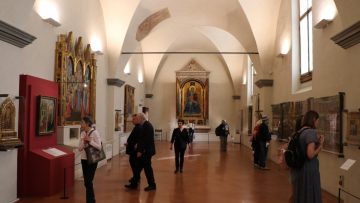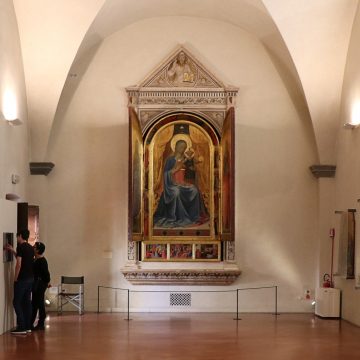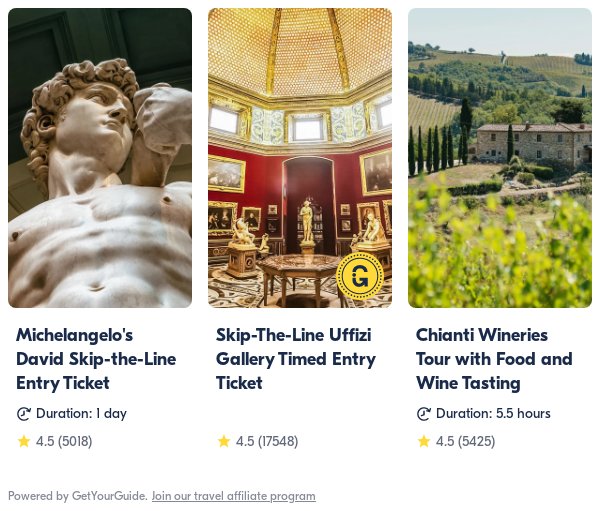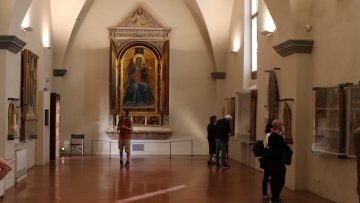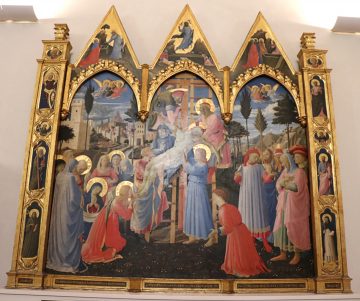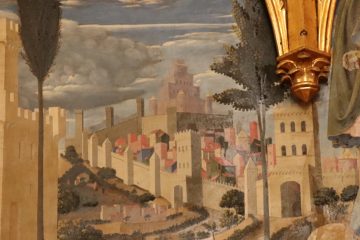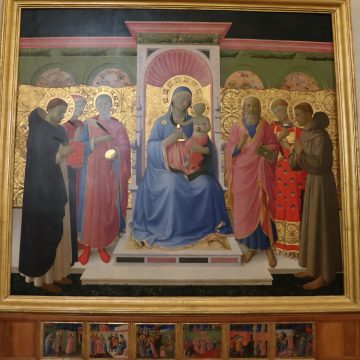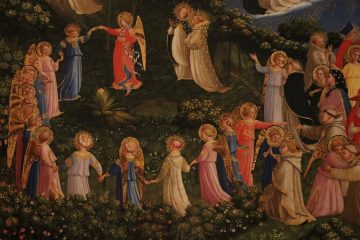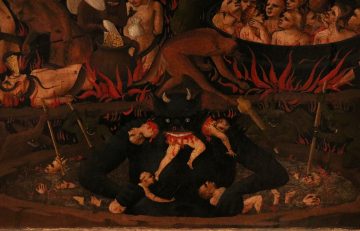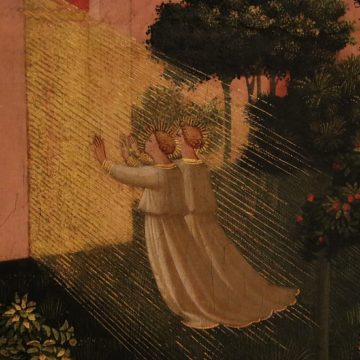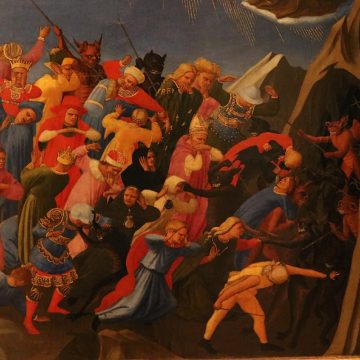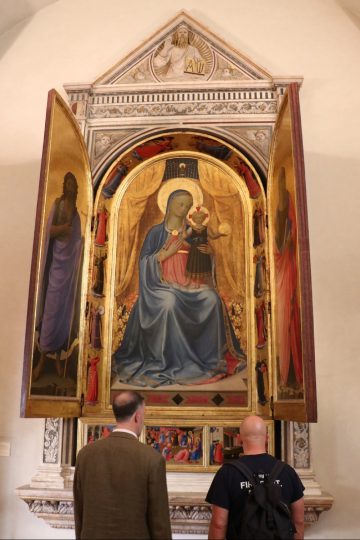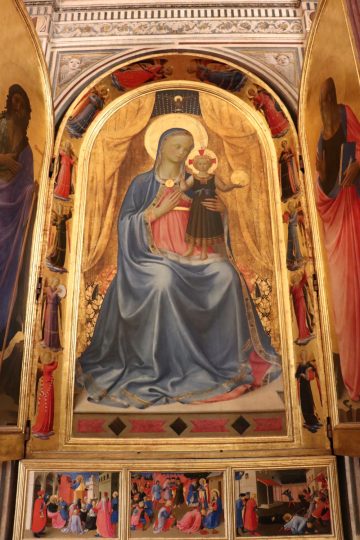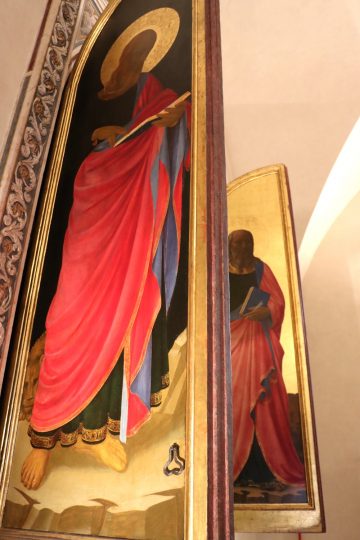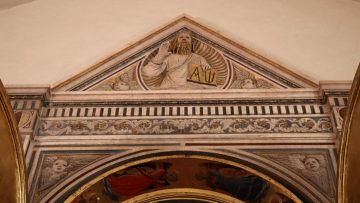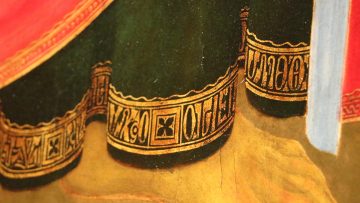Many of the best early Renaissance paintings and altarpieces by Fra Angelico are exhibited in the San Marco Museum in Florence.
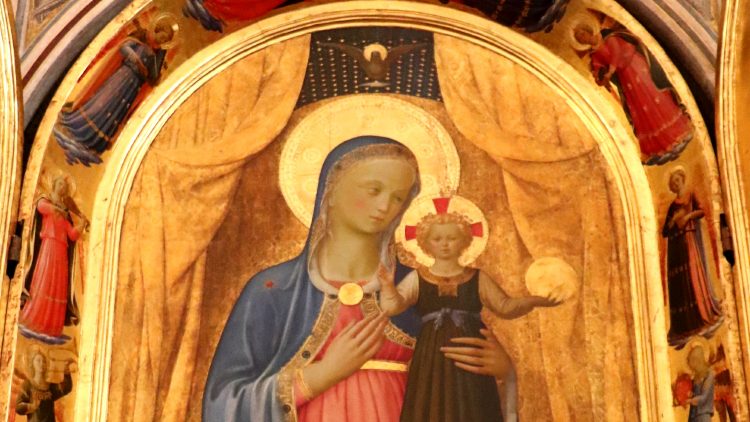
The pilgrims’ hospice of the former convent of San Marco in Florence has the world’s largest collection of altarpieces and paintings by Fra Angelico. Famous altarpieces on display include the Deposition from Santa Trinita, the Annalena Altarpiece, and the main painting from the altarpiece from the adjacent San Marco church. The Tabernacle of the Linaioli is the largest work with a marble frame designed by Lorenzo Ghiberti. The museum also has an early Last Judgment. The San Marco Museum further has a very large number of frescoes by Fra Angelico. Buy skip-the-line time-slot reservation tickets online, especially during the high season.
→ Top museums, churches, and sights in Florence are open mostly as normal in 2024 — see 2024: Florence Opening Hours of Top Sights, Museums, and Churches for the latest information and opening hours. The Firenzecard is again sold while the Turbopass Florence City Pass is a good alternative that includes online timeslot reservations for both the Uffizi and Accademia.
Fra Angelico Museum in Florence
The San Marco Museum in Florence is sometimes called the Museum of Fra Angelico. Although the monastery building itself is also very interesting to see, the main draw is the art by Fra Angelico.
The largest collection of Fra Angelico’s work is on display in the San Marco Museum in Florence. Here, many of his altarpieces and other paintings on wood are in the former hospice of the convent. Of course, the large number of frescoes in the cells of the convent is also a major attraction and included in any visit to the museum.
Fra Angelico of Fiesole and San Marco in Florence
The most famous friar in the over 500-year history of the Dominican convent of San Marco in Florence was Fra Angelico (c. 1395-1455); Fra meaning friar or brother. Born Guido di Pietro, he was given the name Fra Giovanni da Fiesole (Brother John of Fiesole) when entering the Dominican order but later usually referred to as Fra Angelico (angelic), as John was such a common name amongst monks.
Fra Angelico was beatified in 1982 and thus is known in modern Italian as Beato Angelico (the blessed) but in most other languages Fra was not upgraded and Fra Angelico remained in more common use.
The friars of the convent of San Marco did not live in isolation, as were often the case for monasteries in the period — many brothers were the third and later sons of nobility. Fra Angelico thus operated practically like any other artist of the period with a studio and assistants. He accepted commissions from various sources but painted only religious scenes for churches, monasteries, and similar religious institutions rather than for palaces and civic buildings. As a Dominican, he foresworn personal earthly possessions and all profits went to the convent.
Fra Angelico lived much of his adult live at San Marco but also accepted commissions in various towns in the region and died in Rome while working on a commission from the Vatican.
The Art of Fra Angelico
Prior to joining the order, Fra Angelico was trained as a miniaturist — an art generally considered very desirable for a monk to illustrate manuscripts. However, he is more famous for his larger paintings, which are full of very fine details.
Although he applied some Renaissance techniques, such as perspective and focus points, Fra Angelico’s works show both early Renaissance and late Gothic aspects, in part due to the conservative themes and patrons. While gold leaf and blue are often used in his altarpieces and paintings for the chapels of wealthy patrons, some of his most memorable works are the far simpler frescoes painted in the cells of San Marco.
Fra Angelico’s works are now highly sought after and also popular in top museum around the world including the Uffizi and Accademia in Florence, Louvre in Paris Prado in Madrid, Gemäldegalerie in Berlin, National Gallery in London, the Metropolitan in New York, and the National Gallery of Art in Washington.
Fra Angelico’s Altarpieces and Paintings in San Marco Museum
The former hospice of the convent of San Marco in Florence is now filled with the art of Fra Angelico. This collection of altarpieces and other paintings of tempera and gold leaf on wood were brought here from various other churches and monasteries in the region.
The article below describes some of the works on display here — for more on the frescoes elsewhere in the museum see Visiting the San Marco Museum to See Art of Fra Angelico for more details.
Deposition from the Cross
Deposition from the Cross (Deposizione, ca. 1432) is an altarpiece originally made for the Strozzi Chapel in the Florentine church of Santa Trinita. It hangs on a sidewall near the entrance and is one of the most famous works in the collection.
Fra Angelico painted the main scene following the death of Lorenzo Monaco who painted the cusps (Noli me tangere — Touch Me Not! / Resurrection / Women at the Sepulchre) and predella panels (Abbot Paphnuntius visiting St Nophrius / Nativity / St Nicholas saving the sailors).
This large painting of tempera and gold leaf on wood measures 176 x 185 cm. It shows a number of people lowering the body of Christ from the cross. Intended for a church, much of it is still medieval including the saints golden halos and unrealistic body of Christ, but Fra Angelico show Renaissance elements of perspective with a clear foreground and background.
It also show the details that Fra Angelico was trained for in the clothes, lashes on Christ’s body, and the wide variety of plants. The city scape in the background on its own would not look out of place in 20th century art. Note the figure dressed in blue with a red hat towards the right showing the crown of thorns and nails from the cross — these would feed reliquaries and pilgrims all over Europe for centuries.
This altar was commissioned by the wealthy Strozzi family — they had several further altars in Santa Croce too — which explains the use of expensive gold leaf and blue, although the blues now are not as bright in reality as shown on many over-edited photos.
Triptych of St Peter Martyr
The Triptych of St Peter Martyr (San Pietro Martire, before 1429) shows the Madonna Enthroned with Child) and, at the sides, Saints Dominic, John the Baptist, Peter of Verona, and Thomas Aquinas. This painting showed an increasingly realistic approach and the influence of Masaccio (Crucifixion in Santa Maria Novella).
Peter of Verona, or St Peter Martyr, was a Dominican priest who was murdered when struck in the head by an ax. His bloodied head is frequently seen in frescoes in San Marco.
Annalena Altarpiece
The Annalena Altarpiece (Pala d’Annalena, ca. 1434, 180 x 202 cm) is an early full Renaissance work due to perspective and spatial arrangement. It is one of the earliest Sacred Conversation pieces in Florence — the holy figure of Mary is shown almost like a normal person and on the same level as mere mortals. It is often used to display patron saints in the company of the Madonna and Child.
This altarpiece was made for the Annalena convent in Florence on order from Cosimo the Elder. Not surprisingly, it shows the Medici’s patron saints Cosima and Damian. The predella paintings show events from the lives of these two saints.
Last Judgment
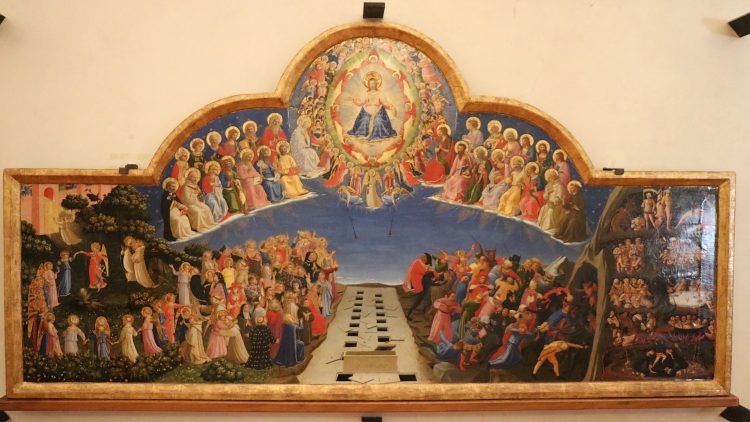
Last Judgment (Giudizio universale, ca. 105 x 210) is an early work and dated between 1425 and the more likely 1431. It is an unusual shape due to it original location in the convent of Santa Maria degli Agneli.
The iconography is fairly typical — Christ surrounded by angels and the saints sits in judgement with his right hand pointing up to heaven and his left down to hell. At the center is a row of broken tombs indication that the dead has risen.
As often with Fra Angelico, the details are impressive in the clothing and the variety of plants in the paradise section. The joyful embrace and the peaceful circle were inspired by Plato rather than the Christian Bible itself. Toward the far left, two blessed persons are welcomed into heaven, symbolized by the rays of light.
The condemned, including numerous royals and senior clergy among the commoners, are driven to hell. The torments in hell, as well as the three-headed Satan that eats three human bodies simultaneously, are familiar themes from Dante’s Hell.
Further Last Judgment paintings by Fra Angelico are in the Accademia in Florence and the Gemäldegalerie in Berlin.
Altarpiece from San Marco Church
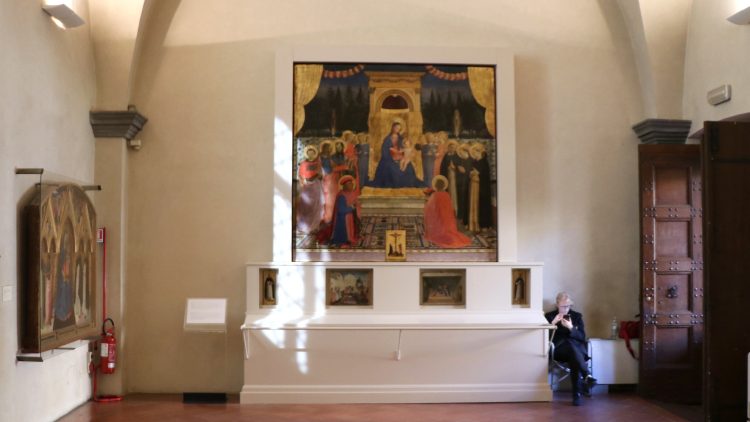
The Altarpiece from San Marco (also Madonna and Saints) is considered one of Fra Angelico’s masterpieces. It is considered one of the finest early Renaissance paintings for its use of metaphor and perspective, and mixing of Dominican themes and symbols with contemporary messages. It is a relatively late work completed between 1438 and 1443.
This altarpiece was commissioned by Cosimo de’ Medici the Elder for the Church of San Marco and is shown in the museum with the main tempera on wood painting (220 x 227 cm) and only two of the original nine predella panels.
At the center is the Madonna and Child — directly in line with the trompe l’oeil crucifixion painting at the bottom — surrounded by angels and saints. Fra Angelico positioned the saints and used the carpet in the foreground to create a logical space and depth. Read more about the symbols and religious significance of this work on Wikipedia.
Wardrobe of the Silversmiths
The Wardrobe of the Silversmiths (Armadio degli Argenti, 1451-53) was the last major work of Fra Angelico. It is a set of nine panels with a series of 35 cartoons telling stories from the life of Christ. These wooden panels formed a container to house silver votive offerings in a Medici chapel in Santissima Annunziata in Florence.
Most of the panels are by Fra Angelico but at least three are by another hand and several panels were completed by assistants.
The Tabernacle of the Linaioli
The Tabernacle of the Linaioli (Tabernacolo dei Linaioli, 1433-34) is a huge tabernacle painting by Fra Angelico with a marble frame designed by Lorenzo Ghiberti. It measures 260 x 330 cm. It was commissioned by the guild of linen workers, which explains the exquisite details of the drapery and emphasis on textiles. Originally displayed at the old market in Florence, it moved to the Uffizi in the 18th century but the San Marco Museum secured it in 1924.
The central painting is the Madonna and Child surrounded by twelve musician angels and a dove above the Virgin. The shutter panels have on the inside St John the Baptist (left) and St John the Evangelist (right) and on the outside St Mark the Evangelist (left) and St Peter (right).

The three predella panels show St Peter dictating the gospel to St Mark, Adoration of the Magi, and the Martyrdom of St Mark. The emphasis on St Mark has nothing to do with the San Marco convent — that is purely coincidence — St Mark is the patron saint of cloth makers.
For more on the frescoes by Fra Angelico in the convent, see Visiting the San Marco Museum in Florence for more details and practical information for visitors.
More Articles on Florence Sights
The high season in Florence is increasingly long: Easter, May, July, August, and the Christmas holidays are especially busy. November and January to mid-March are the only quiet months. Plan and book time-slot reservation tickets and tours when available in advance — the Accademia and the Uffizi are again sold out weeks in advance. Top sights are quieter directly at opening time or in the late afternoon.
→ → Special opening hours for top sights in 2024 — most sights are open normal hours in 2024 but advance time-slot reservations when available are always sensible even for sights where bookings are optional.
- Tips on Buying Tickets for the Uffizi Museum
- Tips on Buying Skip-the-Line Tickets for the Accademia (Michelangelo’s David)
- See Michelangelo’s David in the Galleria dell’ Accademia
- Visit the Duomo sights: Cathedral (Duomo), Baptistery (Battistero), Bell Tower (Campanile), Dome (Cupola), Museum (Museo), and Tickets + Opening Hours
- Visit the Bargello Museum of Sculpture (Donatello’s Davids)
- Visit San Marco Museum to see the frescoes and altarpieces painted by Fra Angelico.
- Visit Santa Maria Novella Church and Museum to see medieval and Renaissance Art.
- Visit Santa Croce for Giotto Frescoes and Michelangelo’s Grave
- San Lorenzo complex: Visit the Basilica for Renaissance Art, See the Laurentian Medici Library by Michelangelo, and Visit the Medici Chapels (Michelangelo Statues)
- Save on Sightseeing in Florence with the Firenze Card (again available but not including transportation or the Duomo sights, or consider the Turbopass Florence City Pass that includes online timeslot reservations for both the Uffizi and Accademia.
- Travel to Pisa to see the Field of Miracles and the Leaning Tower of Pisa.
- Visit the magnificent Romanesque-Gothic cathedral in nearby Siena.
- Save on top Italian designer fashion at The Mall Factory Outlet Stores.
Florence Resources
- The official Firenze Tourist Office website is a bit cumbersome but has very useful information. Especially the pdf (alternative link) with the opening hours of all major sights. Unfortunately, it is only available for the current month but it is the second last line on opening hours — the final say is the guard at the door, NOT the ticket window!
- Get Your Guide offers tours of all major sights while Tiqets sells online tickets for many top sights in Florence.
- Book luggage storage online and explore Florence more easily on foot.
- Trainline is good for booking online train tickets in Italy and most of Europe.
